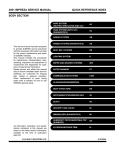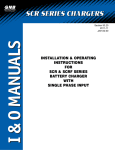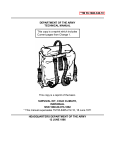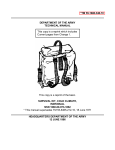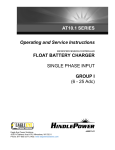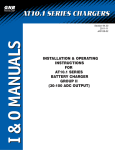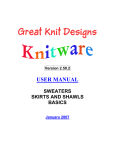Download AVIATION RESCUE SWIMMER DRY SUIT AIR
Transcript
MSD660vAF SENTINEL – AVIATION RESCUE SWIMMER DRY SUIT AIR NATIONAL GUARD DO NOT REMOVE PRIOR TO SALE HT0661 (Rev12Jun2012) TABLE OF CONTENTS DESCRIPTION...................................................................................... 1 MSD660vAF – Aviation Rescue Swimmer Dry Suit.......................... 1 Air National Guard......................................................................... 1 SENTINEL SERIES SIZING GUIDE........................................................... 3 STEP 1 – Measuring........................................................................ 3 STEP 2 – Sizing............................................................................... 4 STEP 3 – Suit Length...................................................................... 5 INSTRUCTIONS FOR USE..................................................................... 5 Neck Seals and Wrist Fitting .......................................................... 5 Attaching Suspenders..................................................................... 6 DONNING THE SUIT............................................................................ 7 CLEANING AND MAINTENANCE......................................................... 9 Cleaning......................................................................................... 9 Maintenance.................................................................................. 9 STORING THE DRY SUIT.................................................................... 10 Folding and Packing..................................................................... 10 LEAK TESTING.................................................................................. 10 Leak Testing Procedure................................................................. 11 REPAIRS............................................................................................ 14 RAPID REPAIR NECK SEAL INSTRUCTIONS......................................... 15 Assemble Materials ..................................................................... 15 Heat Remove Current Neck Seal................................................... 15 Prepping the Materials.................................................................. 17 Attaching a Heat Activated Neck Seal........................................... 17 Inspect Replacement..................................................................... 18 RAPID REPAIR WRIST SEAL INSTRUCTIONS........................................ 19 Assemble Materials....................................................................... 19 Heat Remove Current Wrist Seal................................................... 19 Attaching a Heat Activated Wrist Seal.......................................... 21 Inspect Replacement..................................................................... 23 RAPID REPAIR PATCH INSTRUCTIONS................................................ 23 Limits of Repair............................................................................ 23 Assemble Materials....................................................................... 23 Apply Patch.................................................................................. 24 Inspect Repair............................................................................... 25 EXHAUST VALVE REPLACEMENT....................................................... 25 ACCESSORIES................................................................................... 26 Limited Warranty.......................................................................... 27 CONTACT......................................................................................... 28 DESCRIPTION MSD660vAF – AVIATION RESCUE SWIMMER DRY SUIT AIR NATIONAL GUARD The MSD660vAF is a specialized dry suit designed to aid in hypothermia protection during surface operations in or on the water when worn with insulating undergarments. The MSD660vAF uses Mustang Survival’s new platform design. Designed to improve fit and function, the MSD660vAF is based on sound engineering and user feedback. This has been achieved through: • Extensive use of the 2003 CAESER anthropometric data set ensures the sizing and patterns of the suits fit the greatest number of individuals, improving range of motion without adding bulky extra material. Sizing data is based on a review of 2,500 North American 3-D body scans. • Increased number of sizes provides a better fit for end users without customization. • Standard expanded sizing (such as short and tall sizing) for all sizes of suits (Small -3XL). In addition to Mustang’s platform design, the MSD660 has a number of other salient characteristics: • Single-layer waterproof, breathable tri-laminate GORE-TEX® BD6.5 shell fabric. • Heat activated adhesive wrist and neck seals, allow for rapid field replacement of neck and wrist seals with the use of simple field replacement tools. • Reinforced molded foam knee and elbow pads that provide increased knee and elbow protection and wear resistance. (NOTE: All reinforced areas incorporate drainage to preclude entrapped water) • Reinforced seat/thigh area. (NOTE: All reinforced areas incorporate drainage to preclude entrapped water) • Low profile, lightweight, and corrosion resistant TIZIP® waterproof zippers, are easy to operate and require less maintenance than typical waterproof zippers incorporating brass metal teeth. • Right arm air exhaust valve to vent excess trapped air out of the suit. 1 • SOLAS grade retro-reflective tape on the upper shoulders and arms for increased visibility. • Left arm low profile zippered shoulder pocket with dual pen holders. • 2 x 4 inch Velcro® patch located on left chest for attachment of nametag • Left and right thigh elasticized expanding cargo pockets with drainage mesh and Velcro® secured top cover entry, provide maximum storage capacity and exhibit a low-profile function when empty. • Neoprene cummerbund with waist adjustment tabs allows snug waist adjustability without impeding mobility. • Low profile adjustable wrist over cuffs. • Adjustable internal suspenders provided a customized fit and facilitate wearing the suits in the half-doffed position to prevent overheating while preparing for missions or attending a briefing. • Universally sized waterproof, breathable socks are permanently attached and ankle cuffs reduce entry of small debris into footwear thereby reducing wear on the socks. • Waterproof entry and relief zippers are covered to provide flame retardancy and help to protect the zipper teeth from damage or contamination. The MSD660vAF is easily donned/doffed by the wearer using a diagonal watertight entry zipper across the torso and wearer’s left shoulder and includes a relief zipper. Customized fit can be achieved through adjustment of the internal suspenders to modify trunk length for improved range of motion. Every MSD660vAF produced by Mustang is leak tested to ensure waterproof integrity prior to leaving our factory. All suits are 100% tested to ensure the highest level of reliability and performance. WARNING: Dry suits alone provide inadequate protection for extreme climate differences. All users should wear appropriate thermal undergarments to prevent hypothermia (in cold climates) and moisture wicking undergarments to prevent heat stroke (in warm climates). 2 WARNING: Dry suits are not inherently buoyant. All users should wear appropriate flotation devices with the dry suit. Water rescue is inherently dangerous. Users should be aware of risks associated with water rescue and complete training in the use of water rescue equipment and techniques. SENTINEL SERIES SIZING GUIDE The Mobility Based Sizing™ platform is like none other currently in the industry. To order a suit that fits you best, please follow the instructions below: STEP 1 – MEASURING For accurate measurements, please refer to the measurement diagram and instructions provided. All measurements should be taken with a ”tailors” (flexible) tape while wearing garments and any accessories such as body armor usually worn under the dry suit LOCATION 3 VALUE PROCEDURE 1 Chest Measure the horizontal circumference around the chest at maximum girth. For males, this is typically where the tape runs under the armpits at the scye. For females, this is at the bustline. 2 Waist Measure the horizontal circumference around the waist (belt) line. 3 Hips Measure the horizontal circumference around the hips and buttock at maximum girth. 4 Sleeve With your arms horizontal, bent at the elbows, and with your fists touching knuckle-to-knuckle out from the chest, measure the distance from the center of the back along the outside of the arm to the outer tip of the wrist. 5 Inseam Measure the vertical distance from the crotch to the floor. Use a book pressed firmly up between the legs and measure from the top of the book. 6 Torso Hoop With your shoulders relaxed and the tape running over the center of one shoulder and between the legs, measure the vertical trunk circumference 7 Height Vertical standing height with good posture and no footwear. STEP 2 – SIZING Based on your measurements, determine your size according to the chart below. If all your measurements fall between the ranges of two sequential sizes (such as between S and M) select the size that best fits your Torso Hoop and Inseam. Figure 1 MEASURING LOCATIONS 6 1 7 2 3 5 4 LOCATION XS S M L1 L2 XL XXL 3XL Chest 35-38" 37-40" 39-42" 41-44" 43-46" 45-48" 49-52" 53-56" Waist 29-32" 31-34" 34-37" 35-38" 37-40" 41-44" 46-49" 51-54" Hips 37-40" 38-41" 39-42" 40-43" 41-44" 43-46" 47-50" 53-56" Sleeve 29-31" 31-33" 33-35" 34-36" 35-37" 36-38" 37-39" 38-40" Inseam 28-30" 30-32" 32-34" 33-35" 34-36" 34-36" 34-36" 34-36" Torso Hoop 59-62" 62-65" 65-68" 67-70" 69-72" 71-74" 76-79" 78-81" 4 STEP 3 – SUIT LENGTH Based on your height, determine your suit length according to the chart below. HEIGHT XS S M L1 L2 XL XXL 3XL Short 57-60" 61-64" 65-68" 66-69" 68-71" 70-73" 72-75" 72-75" Regular 60-63" 64-67" 68-71" 69-72" 71-74" 73-76" 75-78" 75-78" Long 63/66/" 67/70/" 71/74/" 72/75/" 74/77/" 76/79/" 78/81/" 78/81/" Following Steps 1 - 3 should bring you to one comprehensive size such as L1 Short or Medium Regular, which is a combination of your overall measurements (chest, waist, etc.) and your height. *Please note: If all your measurement DO NOT fall into the range of two sequential sizes, for example, chest measurement is Medium but Waist measurement is in L2, you may require a full customized suit. Please contact your Mustang Survival Representative for more information. INSTRUCTIONS FOR USE This manual supplies instructional, maintenance and safety information for the MSD660, Aviation Rescue Swimmer’s Dry Suit. NECK SEALS AND WRIST FITTING The Rubber Neck Seals and Wrist Seals may be trimmed at the initial fitting, but the seals tend to adjust to the wearer after a short period of time. If no excessive seal restriction exists, and seal fit is acceptable to the user, the seals should be left as is. Neck seals shall fit snugly and remain in direct contact with the neck through all normal head movements. Wrist seals shall fit tightly enough to prevent water entry, but not tight enough to restrict blood flow. If seal sizing is required, proceed as follows: CAUTION: Trim neck seals with extreme caution. A smooth trim line is essential. Excessive or careless trimming could result in loose seals that leak and necessitate replacement. Avoid nicking seal fabric, as this could result in tearing the seals when donning and doffing, and also could result in skin irritation. 1. If neck seal trimming is necessary, mark a line around circumference of neck opening. Trimming increments shall not exceed 1/4 inch at a time. 5 2. Carefully cut along this line with a sharp pair of scissors. 3. Trim wrist seals in same manner as neck seals, except trimming increments shall not exceed 1/8 inch at a time. 4. After trimming seals, have the user don the suit to determine seal restriction and water-sealing characteristics. Make any additional adjustments to the seal. ATTACHING SUSPENDERS Figure 2 To attach suspenders please follow the instructions below. The removable suspenders can be used to improve fit, lower in-water resistance and reduce rescuer fatigue. Suspenders can be adjusted to a comfortable and secure position. Figure 3 1. C ompletely unzip the entry zipper. 2. Open the suit so that the two attachment points are visible. 3. Thread the end of the nylon strap attached to the suit through the rectangular clip on the suspenders. 4. Once the nylon strap has been threaded, flare the sewn folds on the strap to prevent it from passing back through the rectangular clip. Figure 4 Figure 5 6 5. Repeat these steps for the other attachment point. 6. Use the suspender strap ends to adjust for a secure comfortable fit. DONNING THE SUIT Before donning the suit, ensure that appropriate undergarments have been selected for the conditions. CAUTION: Always don the dry suit on a clean surface such as a towel or tarp to avoid attracting debris. Pebbles, sand, dirt and other debris on the ground can cause damage to dry suit sock and compromise the suit’s integrity. CAUTION: Use extreme care when donning the dry suit. Prior to donning, remove all rings, watches, earrings, necklaces and eyeglasses that will cause damage to wrist and neck seals. Footwear other than socks must not be worn inside the dry suit. Suit Preparation Prior to Donning 1. Ensure that the Velcro® wrist covers are unfastened and the ankle gussets are unzipped and opened. 2. Ensure Velcro® waist adjusters are loosened. 3. Ensure that the waterproof entry zipper is fully opened. 4. Ensure the suspenders are pulled out of the suit legs. Donning the Suit 1. Slide your legs into the suit until your toes reach the end of the socks. 2. Don the suspenders. Ensure they are crossed in back but not twisted. 3. Apply talcum powder inside wrist seals. 4. Place the right arm into the right sleeve. 5. Carefully place the right hand into the right cuff by pointing the fingers straight, tucking the thumb underneath and inserting the hand through the seal. Do not make a fist when putting your wrist through the seal. 6. Roll the Velcro® wrist covers back and refasten to a snug fit. 7 7. Repeat Steps 4 - 6 for the left arm. 8. Bring the upper portion of the suit over your head, aligning the neck opening with the top of the head. Reach inside the top of the neck seal with fingers and gently pull the seal outward and down as you push your head through. Flatten any folds or rolls of the seal against the skin. 9. Close the waterproof entry zipper. Reach over your left shoulder with your right hand and grasp the zipper toggle. While holding the top of the zipper, pull the toggle down until the zipper is completely fastened.10. Ensure the waterproof relief zipper is completely closed and the slider is fully engaged with the zipper stop. Stow the zipper toggle in the yellow loop located under the zipper cover. WARNING: Failure to completely close the waterproof entry zipper and the relief zipper will result in leakage of water inside the suit and reduction of survival time when in the water. Have a fellow team member doublecheck each slide fastener to ensure they are completely closed against their sealing plugs. 11. Close ankle gusset zippers and securely fasten the Velcro® adjustment tabs. 12. Burp the suit before water entry. Cross arms in front and gently slide fingers between the neck seal and your neck, squat down and force excess air through the neck opening. Doffing the dry suit 1. Remove all equipment worn over the suit. 2. Thoroughly rinse down the exterior of the suit while wearing it, paying special attention to the seals and zippers. Remove all dirt, salt and debris. 3. Loosen Velcro® waist and ankle adjustment tabs. Unzip the ankle zippers. 4. Completely open the waterproof zipper. If not completely open, the zipper faces the risk of damage to the zipper during doffing. CAUTION: Placing undue force on the zipper may damage the seal and harm the integrity of the suit. Never forcefully yank on the zipper. 8 5. Insert fingers between neck seal and neck. Gently stretch the seal outward and upward while pulling neck seal over your head. 6. With an unclenched fist, slowly pull each hand through wrist seals while holding the rubber seal open. CAUTION: Pulling on the rubber wrist seal may damage the seal. NOTE: If wearing suspenders, remove suspenders prior to proceeding 8. Pull suit down past hips and slide legs from the suit. 9. Follow the cleaning and storage instructions for the suit. CLEANING AND MAINTENANCE CLEANING 1. Thoroughly rinse your dry suit after every use. CAUTION: Do not dry clean. Do not iron. Do not bleach. 2. Treat stains with a pre-wash treatment such as Shout® or Spray ‘n Wash®. Follow the manufacturer’s instructions. Rinse well. 3. Machine wash warm (104° F/40° C) on gentle cycle using a gentle powder or liquid detergent. Do not use fabric softener, bleach or wash-in treatments, as they can affect the suit’s breathability. 4. Tumble-dry using an air setting MAINTENANCE Regular zipper maintenance is recommended to maintain a water-tight seal, inhibit corrosion and keep the zipper gliding freely. These steps are essential to zipper longevity: 1. Clean the zipper of any heavy deposits of mud, sand, salt or foreign substances using warm soapy water. 2. TIZIP® MasterSeal zippers need to be lubricated on the docking end from time to time. Please use the original TIZIP® lubricant or other available zipper lubricant as listed below. 3. Carefully apply over the docking end surfaces on front and back and inside where they connect to the zipper chain. 9 CAUTION: TIZIP® MasterSeal zippers do not require the zipper chain to be lubricated, only the docking end. Lubricating the zipper chain may affect the zippers performance and is not recommended. 4. Repeat before long term storage leaving the slider closed and whenever the area is dry during use. Care Product Product Name Supplier Cleaning Fluid Zip Care Lubricant McNett Tizip Lubricating Zip Tech Lubricant McNett Tizip STORING THE DRY SUIT Hang the suit with all zippers open. FOLDING AND PACKING 1. Ensure that the suit is thoroughly clean and dry and that the main entry zipper is in the closed position before folding and packing. 2. Lay the suit flat on its back on a horizontal; clean surface, allowing the suit to be fully extended with none of the parts overlapping. 3. Fold the left sleeve, from the shoulder, straight across the body of the suit. Fold the right sleeve, from the shoulder, straight across the body of the suit on top of the folded left arm. 4. Fold the socks over top of the legs until they reach crotch level. 5. Fold the legs, from the crotch, up to the chest level, right below the folded sleeves. 6. Fold the suit in half. 7. To pack, roll or fold the suit ensuring that the zippers do not crease. LEAK TESTING Leak testing is an important part of regular care and maintenance. Follow these instructions to test for leaks. 10 NOTE: Mustang recommends the use of its MA8836 Dry Suit Test Kit when performing leak testing. If using alternate test equipment, care should be taken not to damage the wrist or neck seals. Figure 6 During testing, all components, seams, sealed areas, and attachments shall remain intact and shall not show any sign of separation, leakage, or other damage. Have a qualified technician test for leaks after suit repairs, on periodic inspection, prior to issue and every six months thereafter, and when a visual inspection raises any doubt about the integrity of the suit’s waterproofing. To perform the suit leakage test: Turn the suit inside out, with the entry zipper and relief zipper slide fasteners fully closed. LEAK TESTING PROCEDURE The following suit leakage test uses Mustang Survival Dry Suit Test Kit (MA8836). Your equipment may differ and, if so, the test should be adjusted accordingly. 1. Completely loosen the adjustable neck seal, if equipped. Turn the dry suit inside out. 2. Place the neck plug into the dry suit, through the main entry zipper. Close the main entry zipper by reaching in through the neck opening to pull the zipper toggle. Figure 7 11 Figure 8 3. Pull the narrower end of the neck plug through the opening of the neck seal. 4. Stretch the neck seal to fit securely around the neck plug (the end with the smaller diameter). Figure 9 Figure 10 5. Fit the cinching strap over the neck seal. 6. Secure the cinching strap by pulling up the excess strap, and fasten the Velcro closures. Figure 11 Figure 12 7. Clamp both wrist seals with the clamps provided. 8. Connect the two coiled pneumatic hoses to the output side of the control box. The two hoses are interchangeable. Figure 13 Figure 14 12 9. Connect the other ends of the coiled hoses to the neck plug. It does not matter which hose connects to which plug. Figure 15 shows the correct configuration. 10. Ensure your configuration matches Figure 16, that shows the two coiled pneumatic hoses correctly attached to the control box and the neck plug. Figure 15 Figure 16 11. Connect high-pressure air source to the input side of the control box. The air pressure should be no greater than 150 psi. NOTE: Ensure the control lever is set in the off position before the high-pressure air is connected. 12. The control box has one pressure gauge and two controls. The black control lever has three positions as labeled on the control box. The knurled knob can be turned to restrict the airflow traveling into the dry suit. 13. Move the control lever to the fast position. The suit should inflate rapidly. Once the suit appears ¾ inflated, move the lever to the slow position. Turn the knurled knob to restrict the airflow rate until the suit inflates up to 12 in. water pressure. Twist the knurled knob further to hold pressure inside the suit at 12 in. water. Figure 17 13 Figure 18 14. Spray the entire suit with a gentle soap and water solution of 0.5% soap to water by weight. Pay particular attention to the seams and zippers. 15. Examine any area of the suit where bubbles are forming and take action depending on the severity as follows (note that bubbles forming at a rate of less than one per second are probably not leaks): 16. Small foamy bubbles collecting slowly on seam: Entrapped air. No leak present, no action required. 17. Small foamy bubbles collecting quickly on seam: Uncertain. Agitate seam around bubbles to remove any entrapped air. If bubbles persist after 10 minutes then consider as leak, mark leak area with a china marker, and document on the inspection record. 18. Steady stream of larger bubbles: Leak. Mark leak area and document on the inspection record. 19. Any other type of bubble formation or any sign of bubbles on a panel shall be treated as a leak. 20. When the test is completed, move the control lever to the off position. Remove the clamps from the suit and disassemble the rest of the test kit. Hang the suit to dry. SUMMARY The Mustang Survival Dry Suit Test Kit Model MA8836 should be used with Mustang Survival dry suits. Ensure qualified technicians use this equipment. A well-maintained suit means survival in emergencies for which normal clothes were not designed. CAUTION: The use of metal hangars may damage the dry suit. REPAIRS The protection provided by this dry suit relies very much on its watertight characteristics. It is extremely important that damaged suits are handled in accordance with the following repair requirements. If your suit is configured for use with Mustang’s heat activated seal replacement system, seal replacement can be accomplished by following the instructions provided in the section below. Qualified repair personnel can normally perform minor repairs, with adequate facilities. The manufacturer should perform all major repairs. 14 RAPID REPAIR NECK SEAL INSTRUCTIONS An online video tutorial of this procedure is available for viewing at mustangsurvival.com. It may be helpful to watch this video in addition to the instructions below. ASSEMBLE MATERIALS Make sure that you have all of the necessary equipment and materials to perform the neck seal replacement correctly. You will need ONE of the following tool kits: Rapid Repair Neck and Wrist Seal Tool Kit (Part# RE0001) OR Rapid Repair Neck Seal Tool Kit (Part# RE0002) & Rapid Repair Hand Iron (Part# RE0004) Tools and Equipment Supplied by User: Light work gloves Additionally you’ll need ONE of the following Rapid Repair Neck Seals: SEAL PART# SEAL DESCRIPTION COMES STANDARD WITH SUIT SIZES RE0005-L Rapid Repair Rubber Neck Seal, Thin, Large XS-3XL RE0005-S Rapid Repair Rubber Neck Seal, Thin, Small - RE0006-L Rapid Repair Rubber Neck Seal, Thick, Large XS-3XL RE0006-S Rapid Repair Rubber Neck Seal, Thick, Small - RE0007-L Rapid Repair Neoprene Neck Seal, Large XL-3XL RE0007-M Rapid Repair Neoprene Neck Seal, Medium M-L2 RE0007-S Rapid Repair Neoprene Neck Seal, Small S RE0007-XS Rapid Repair Neoprene Neck Seal, Extra Small XS HEAT REMOVE CURRENT NECK SEAL The neck seal in your current dry suit can be removed by using a simple heating method with a Mustang Hand Iron. 1. Preheat the iron to its maximum temperature, approximately 310 ºF. 2. Place the circle jig inside the suit, white side up, in the middle of the neck seal opening. A properly placed jig will make a nice flat surface for the seal to sit against, with the bulk of the suit and collar out of the way. See Figure 19. 15 3. Flatten out wrinkles around the perimeter of the neck seal attachment area. Make sure there are no materials caught between the circle jig and the neck seal. 4. Pick a point on the neck seal as a starting point and heat until adhesive has softened, approximately 15 seconds. See Figure 20. Figure 19 Figure 20 5. Grab neck seal and pull the neck seal away from the suit using only light force. The neck seal will separate from the suit in the area that was heated. Gloves may help as the neck seal will be hot where contacted by the iron. See Figure 21. CAUTION: Stop pulling the neck seal away from the suit when resistance is encountered. 6. Continue to heat an adjacent section of the neck seal for 15 seconds. 7. Lightly pull the neck seal to detach the adjacent section. 8. Repeat steps 6-7 until the old neck seal has been removed. 9. Remove the circle jig from the suit when finished. Figure 21 Figure 22 16 PREPPING THE MATERIALS Once the existing neck seal is removed, it is time to prepare the materials for the neck seal replacement. Make sure you have all of your tools and materials nearby during the replacement process. 1. With the circle jig still inside the suit, center the jig in the middle of the neck seal opening. You should have about 1” of suit material around the outside of the circle jig. See Figure 23. Figure 23 Figure 24 3. Peel the backing paper off the replacement heat activated neck seal. 4. Place the replacement neck seal into the opening on the suit. The heat adhesive portion of the neck seal should be inside the suit facing up. There should be a 1/8 inch edge of adhesive visible around the edge of the suit. Figure 25 See Figure 24. 5. Ensure that there are no wrinkles in the fabric or neck seal. Folding the neck seal in on itself will help to keep its shape and aid in the replacement process. See Figure 25. ATTACHING A HEAT ACTIVATED NECK SEAL Once your materials are prepped you are ready to attach your new neck seal. 1. Preheat hand iron to its maximum temperature, approximately 310 ºF. 2. Start by heating small sections around the edge of the neck seal for 3 – 5 seconds to tack and hold the neck seal in place. Continue to check the alignment before heating each spot. See Figure 26. 17 Figure 26 Figure 27 3. Once the neck seal has been tacked in at least 10 places, lightly heat the entire outside of the neck seal to tack all portions of the seal into place. 4. Cover the neck seal with the non-stick fabric template provided. Carefully use the iron to melt the adhesive on the neck seal. Apply heat to a single section for at least 30 seconds using maximum hand pressure before advancing iron to the next section leaving some overlap with the previously heated section. See Figure 27. 5. Continue around the perimeter of the neck seal applying heat and pressure. 6. Let the neck seal and fabric cool and then remove the circle jig. 7. Inspect for proper adhesion by examining the entire perimeter on both the inside and outside of the suit. 8. Pinhole leaks may be corrected by re-heating the area for an additional 30 seconds using maximum pressure. INSPECT REPLACEMENT After installation is complete the suit should be leak tested before use. If a leak originates from a wrinkle in the fabric, the neck seal should be removed and a fresh neck seal installed. Repeat the leak test. Once you have verified there are no leaks your new neck seal is now ready to be used. 18 RAPID REPAIR WRIST SEAL INSTRUCTIONS An online video tutorial of this procedure is available for viewing at mustangsurvival.com. It may be helpful to watch this video in addition to the instructions below. ASSEMBLE MATERIALS Make sure that you have all of the necessary equipment and materials to perform the wrist seal replacement correctly. You will need ONE of the following tool kits: Rapid Repair Neck and Wirst Seal Tool Kit (Part# RE0001) OR Rapid Repair Wrist Seal Tool Kit (Part# RE0003) & Rapid Repair Hand Iron (Part# RE0004) Tools and Equiptment Supplied by User: Light work gloves Additionally you’ll need ONE of the following Rapid Repair Wrist Seals: SEAL PART# SEAL DESCRIPTION COMES STANDARD RE0008-M Rapid Repair Rubber Wrist Seal, Thin, Medium XS-3XL RE0008-S Rapid Repair Rubber Wrist Seal, Thin, Small - RE0009-L Rapid Repair Neoprene Neck Seal, Large XL-3XL RE0009-M Rapid Repair Neoprene Neck Seal, Medium M-L2 RE0009-S Rapid Repair Neoprene Neck Seal, Small S WITH SUIT SIZES HEAT REMOVE CURRENT WRIST SEAL The wrist seal in your current dry suit can be removed by using a simple heating method with a Mustang Hand Iron. All steps should be practiced prior to applications with heat. 1. Preheat the iron to its maximum temperature, approximately 310 ºF. 2. Roll the jig to form the smallest possible diameter. See Figure 28. 3. Place the jig inside the suit. See Figure 29. 4. Center the jig about the seal and fabric interface. 19 Figure 28 Figure 29 5. Stretch the jig until the ends meet forming a cylindrical shape. See Figure 30. 6. Flatten out wrinkles around the wrist seal attachment area. 7. Lay the wrist seal flat and place the non-stick fabric sheet on top. 8. Press the iron on the non-stick fabric sheet with moderate pressure for 30 seconds. See Figure 31. Figure 30 Figure 31 9. Remove the iron from the surface 10. Gently separate the seal from the fabric by lightly peeling. Gloves may help as the wrist seal will be hot where contacted by the iron. See Figure 32. CAUTION: Stop pulling the wrist seal away from the suit when resistance is encountered. 11. Heat the adjacent area for 20 seconds and continue to pull. 12. Rotate the wrist seal and repeat steps 9 to 12 until the seal has been completely separated. See Figure 33. 13. Leave the wrist seal and sleeve to cool prior to completing any further actions. Gloves may help as the wrist seal will be hot where contacted by the iron. 20 Figure 32 Figure 33 ATTACHING A HEAT ACTIVATED WRIST SEAL The wrist seal in your current dry suit can be applied by using a simple heating method with a Mustang Hand Iron. All steps should be practiced prior to applications with heat. 1. Preheat hand iron to its maximum temperature, approximately 310 ºF. 2. Flip the suit right side out. 3. Remove adhesive paper backing from wrist seal. 4. Roll the Wrist Seal replacement jig and place it into the wrist seal. See Figure 34. Figure 34 Figure 35 5. Line up the jig such that approximately ¼” of the jig is exposed. 6. Stretch the wrist seal jig until the ends meet to form a cylindrical shape. See Figure 35. 7. Insert the jig and wrist seal into the sleeve from the inside. Ensure that dry suit seam lines up with the seam of the wrist seal jig. 8. Ensure the suit arm becomes taut and 1/8” of adhesive protrudes from the cuff end. See Figure 36. 9. Flatten the cuff such that the seam appears right of center. See Figure 37. 21 Figure 36 Figure 37 10. Center the non-stick paper over the wrist seal where the seal and suit meet and press the iron with moderate pressure for approximately 30 seconds. See Figure 38. 11. Leave the non-stick sheet on the seal for approximately 10 seconds before removing. Figure 38 Figure 39 12. Clean off any adhesive that has attached to the non-stick paper. See Figure 39. 13. Continue around the circumference of the wrist seal applying heat and pressure to each adjacent section for 30 seconds. 14. The following steps (14a-15d) are performed for rubber wrist seals only. Do not perform these steps with neoprene wrist seals. a. Remove the wrist seal jig. b. Invert the suit sleeve inside out. c. Re-insert the wrist seal jig. d. Press the region around the seam of the dry suit for 30 seconds to ensure complete adhesion. See Figure 40. 22 15. Let the wrist seal and fabric Figure 40 cool and then remove the jig. 16. Inspect for proper adhesion by examining the entire perimeter on both the inside and outside of the suit. 17. Pinhole leaks may be corrected by re-heating the area for an additional 30 seconds using maximum pressure. INSPECT REPLACEMENT After installation is complete the suit should be leak tested before use. If a leak originates from a wrinkle in the fabric, the wrist seal should be removed and a fresh neck seal installed. Repeat the leak test. Once you have verified there are no leaks your new wrist seal is now ready to be used. RAPID REPAIR PATCH INSTRUCTIONS An online video tutorial of this procedure is available for viewing at mustangsurvival.com. It may be helpful to watch this video in addition to the instructions below. LIMITS OF REPAIR It is recommended that the following guidelines be used in determining potential for repair: • Pinholes and small slits, cuts and tears less than 1 inch in length may be patched by the heat-sealing method. • Do not patch the neck or wrist seals or socks. • The total area of patches should not exceed 10% of the suit. Repair no more than 10% of any one panel. • Any holes larger than a small slit, cut or tear less than 1 inch in length should be sent to Mustang Survival for repair. ASSEMBLE MATERIALS Make sure that you have all of the necessary equipment and materials to perform the puncture repair correctly. A list is provided below: Rapid Repair Dry Suit Patches (Part# RE0010) Rapid Repair Hand Iron (Part# RE0004) 23 APPLY PATCH The puncture in your dry suit can be repaired using a simple heating method with a Mustang Hand Iron. All steps should be practiced prior to applications with heat. 1. Preheat hand iron to its maximum temperature, approximately 310 ºF. 2. Turn dry suit inside out. 3. Locate puncture. 4. Lay the dry suit on flat surface such that the inside surface of the suit is facing up. 5. Ensure dry suit material is flat and wrinkle free around the puncture. See Figure 41. 6. Ensure area around puncture is both clean and dry. Figure 41 Figure 42 7. Place the shiny side of the patch downwards so that it is in contact with the inside surface of the dry suit. 8. Ensure the patch is centered over the puncture. See Figure 42. 9. Place hot iron on patch and apply pressure perpendicular to the flat surface for approximately 20 – 25 seconds. See Figures 43–44. Figure 43 Figure 44 24 10. Remove iron and turn off. 11. Allow patch and suit to cool for approximately 5 minutes. INSPECT REPAIR After repair is complete the suit should be leak tested before use. It is recommended that a leak test be completed using Mustang Survival’s Dry Suit Test Kit (Mustang P/N MA8836) or equivalent to test the complete integrity of the suit Once you have verified that there are no leaks your suit is ready to be used. EXHAUST VALVE REPLACEMENT The exhaust valves (Part# RE7017) are designed to be easily replaced. They may be unscrewed and removed with little difficulty. Use the following procedure: Figure 45 1. U nscrew the top of the valve housing cover. 3. If necessary, use large pliers to remove the valve. Thread damage as a result of removal is not a concern because the old valve is to be discarded. 4. Unscrew the valve body from its core and remove it from the suit. 5. Remove the rubber gaskets; set all valve parts aside. 6. Place a new valve and flapper into the hole, with the suit material between the rubber gaskets, and screw it together. Hand-tighten only. 7. Perform a leak test to ensure the suit is watertight. 25 ACCESSORIES The following Accessories are available for your MSD660vAF: • Neoprene Survial Hood (Part # MA7348) • Sentinel Dry Suit Liner (Part # MSL600) • Sentinel Female Dry Suit Liner (Part # MSL601) • McNett Zip Tech – zipper lubricant (Part # MA2292) For more information on these items please visit www.mustangsurvival.com. 26 WARRANTY INFORMATION LIMITED WARRANTY Mustang Survival products are warranted to be free from defects in materials and workmanship for a period of one year from the date of purchase by the initial purchaser (the Customer End user) under normal and intended conditions and use. Proof of purchase may be required at the discretion of Mustang Survival. Products, which, in the sole judgment of Mustang Survival, have received excessive or abusive use or have been altered in any way by a dealer, the Customer or any other person, will not be covered by this limited warranty. Mustang Survival requires return of the product (postage or delivery costs prepaid by Customer) for inspection before determining whether the product will be covered under limited warranty. A return authorization is required before the goods are returned and should be obtained by contacting our Customer Service Department. Once returned, Customer Service, Quality Assurance and Sales Departments inspect the product as required. It is then determined whether the product will be covered under this limited warranty. If the product is deemed to be covered under our warranty policy, it will either be repaired or replaced at the sole discretion of Mustang Survival at no charge to the Customer. The only obligation or liability of Mustang Survival under this limited warranty is to repair or replace the product and Mustang Survival shall not, under any circumstances be liable for loss of use or any consequential damages sustained by the Customer. All other warranties expressed or implied, and remedies with respect to the condition or use of the product, which might otherwise be provided by law in any jurisdiction, are specifically excluded. 27 CONTACT For further information concerning this manual or the suit, contact: Mustang Survival Tel: 1.800.526.0532 E-mail: [email protected] Web:mustangsurvival.com 28 Mustang Survival has been providing lifesaving solutions for over 45 years. Through constant innovation and the application of new technologies, Mustang is the leading supplier of quality flotation and hypothermia protection products to the most demanding users — from fishermen, sailors and commercial mariners to the Coast Guard, fighter pilots and even NASA astronauts. WE SAVE LIVES FOR A LIVING mustangsurvival.com TOLL FREE 1.800.526.0532 | EMAIL [email protected] Mustang Survival and seahorse design is a registered trademark of Mustang Survival Corp. Our commitment to quality has earned our Burnaby facilities ISO 9001 registration, the highest of all international standards. This is our guarantee you’re receiving the ultimate in design and manufacturing.



































